Ransomware threats have become dreadfully frequent and widespread, such that they are undoubtedly the biggest threat in the cyber world today. Cybercriminals are now using increasingly sophisticated techniques and advanced methods to trick victims and attack their systems. One of the most recurrently used methods is email scams. These specialized encryption algorithms and social engineering skills developed by the ransomware creators cause a great degree of exploitation in the victim’s system, especially if it lacks proper cybersecurity.
It’s crucial for every user, be it an individual or a company, to have proper knowledge of how and what a ransomware attack is capable of doing to your computer, as well as probable methods for ransomware removal and protection.
Let’s explore the various methods and practices used by cybercriminals to deliver malware to a user’s system.
The most common way for ransomware to enter a user’s system is via email as well as through compromised website links. This happens in several ways:
Malicious Attachments – this malware is delivered in the form of an executable file, image or archive via an email. The attached document may seem authentic, and nowhere close to a virus and may be as simple as a resume, a new project or official data analysis of a company. Once the user clicks on the attachment to open it, it is released into the system. However, it may remain dormant for some time and operates in the background until the data locking system is installed in the software and all files are encrypted. Once this happens, the victim is informed about the virus attack through a dialogue box appearing on the screen, demanding a ransom for ransomware removal to unlock the encrypted data again.
Phishing emails- this is a very commonly used scam by these felons to infect your system with malware. It involves collecting personal information of the users through delusive emails and links. Fake, official emails, for example, from banks, providing links to websites are sent to the victims where they end up providing their confidential information such as bank account details and passwords, enabling the malware to enter into the system.
Malicious Links – these deceptive links sent via email, which appear to be genuine, redirect the user to an infected website, resulting in the malware to be downloaded in the system and encrypt the computer’s hard disk. These malicious and fraudulent URLs deceive the victim into clicking them, thereby retrieving information from their systems. However, this may also occur when the user unknowingly visits a website that is infected, resulting in the malware being downloaded without his knowledge.
Once the malware encrypts the files in the victim’s systems, it delivers the message to the user informing them that their files are now inaccessible and can only be decrypted once the ransom payment has been made. In some cases, however, the victim might be presented with a fake message, claiming to be a law enforcement firm that locked the data in the system due to the presence of illegal activities, pirated software or pornography. This basically reduces the likelihood of the victim reporting the attack to the authorities.
Since, you’re now aware of how potential ransomware can enter your computer, take the necessary security steps to prevent the ransomware attacks to hit you! Be cautious of spam emails and extremely vigilant when opening vulnerable websites to protect yourself and your company from exploitation. Hence, it is imperative to adopt preventive measures as ransomware removal and recovery is a difficult and tedious process.




